5 Best Cameras for Astrophotography in 2024 [+Lens Options]
Having the opportunity to single-handedly make your first astrophoto is truly a blessing. You’ll say to yourself; it is really there. No matter how many images you’ve seen of galaxies and nebulae from the most advanced telescopes, you don’t have the sense of their scale, their position in the sky, nor their distance.
Your own astrophotos will give you all of that and through the right camera, your images will be a real joy to edit, post-process, and tweak all day long, just to get the most details out of it. Spending a night under a sea of stars makes you humble how small we really are.
We Recommend
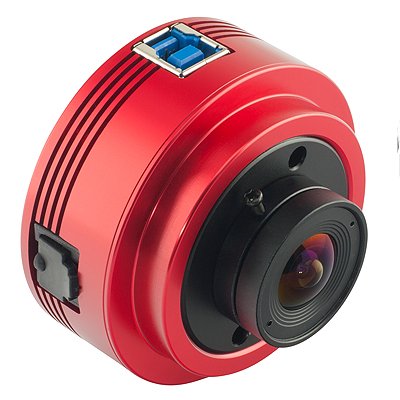
Best for beginners
ZWO
ASI224MC
Best value DSLR
Pentax
K-3 SLR Camera
Best for the money
ZWO
ASI071MC-Pro
What type of camera can be used for astrophotography?
With proper adapters, you can use everything, from your mobile phone to your old DSLR. Back in the days, we used our webcams for imaging the planets in real-time, nowadays there are similar dedicated cameras with far better performances.
- First, I would like to divide the usable astrophotography cameras into two categories: Digital interchangeable-lens cameras (DSLRs and mirrorless) and dedicated astro-cameras.
- DSLRs and mirrorless cameras, when used in astrophotography, are virtually the same since the shutter is not what you use here. This is probably what everybody will start with. Use your own digital camera for astrophotography, no matter how bad it is. I’m sure at the beginning you’ll be worse at editing the images than the camera taking them.
- Later you’ll choose whether to buy a better digital camera that can also be used for regular photography or a dedicated one that will give you far better results at a lower price.
Quick tip: You should use an external power source for your camera, so you’ll never run out of power.
If you are buying the camera only for use with your telescope, then I strongly suggest buying a dedicated astrophotography camera. With a dedicated camera, you’ll have superior low light sensitivity and lower noise.
- Best results you’ll get when using dedicated monochromatic cameras. With monochromatic cameras, you’ll use additional RGB filters or even narrowband filters for false-color images like Hubble’s palette, or you can use a hue that looks best for you.
- With narrowband filters, you’ll get stunning results since the light pollution will be minimized and you can shoot all night long under the strong moonlight. Some higher quality dedicated cameras have their own cooling systems that will bring the noise to a very low level.
- These cameras can have CMOS or CCD sensors. CCD cameras are more expensive and produce really low noise, have a greater dynamic range, that’s why they are used mostly for professional measurements. If you outgrew your CMOS sensor than
Astrophotography camera price timeline
I must stress again that with dedicated astrophotography cameras, you’ll get far better results at a much lower price. And my recommendation, as always, is to use your own DSLR or mirrorless camera at the beginning.
In this list, I would never include the flagship professional digital cameras since you would be paying for the other things that would be completely unusable for long-exposure astrophotography.
Free $0 – That’s the one you own, so please use it.
Starter – up to $250 – In this segment, you can buy an excellent planetary and Moon camera, or an entry-level DSLR. Maybe you should even consider buying a used, nice low light performance DSLR and then remove the infrared filter.
Bargain $250 to $500 – This is where the entry and mid-level DSLR cameras live. If you choose to make regular photography and astrophotography, you can find a nice camera here. Here you can find a used, beat up high-end full-frame camera. You should even consider an older model of a monochromatic dedicated astrophotography camera.
Budget $500 to $850 – We are slowly getting into a nice used full-frame category, something you should think about if you want regular photography and astrophotography. At this price, you can even get a great mid-level dedicated camera with internal cooling.
Advanced $900 to $1600 – In this price range, you have new entry-level full-frame cameras. But this is where you should seriously consider a nice dedicated camera with all the bells and whistles, like integrated cooling and a monochrome sensor.
Pro $2000+ – Astrophotography dedicated cameras with large sensors, 35 mm (full-frame), monochrome CCD, or CMOS with high quantum efficiency, integrated cooling, high dynamic range cameras for astrophotographers who expect top-class results.
Related: 5 Best Telescopes for Astrophotography in 2020 [+The Right Mount]
Modifying a digital camera (DSLR) for astrophotography
If you have a camera that you don’t use it anymore for regular photography or you want to sacrifice it for much better astrophotography than you should ‘modify’ your digital camera. By modifying, we usually think of removing the infrared filter and sometimes even building in an integrated thermoelectric cooler. Integrating a thermal cooler is a really advanced feat, so we’ll stick to just removing the infrared (IR) filter.
Removing the IR filter is a somewhat easy task for people that are used to opening and repairing electronics. Most of the DSLRs are easy for disassembling, just a few screws here and there, then removing a couple of ribbon cables will get you to the sensor where you can remove the IR filter.
Quick tip: If you remove the IR filter, you won’t be able to use the camera for regular photography anymore unless you add on a clip-in or a screw-on UV-IR Cut filter.
Without the IR filter, you’ll have more sensitivity in the red and near-infrared spectrum where some of the ionized hydrogen (Hα) and sulfur (S II) lines are emitted. Singly ionized sulfur (S II) emits light in a very deep part of the red spectrum, beyond H-alpha. It is a weaker emission than H-alpha and O III, but it is the most common filter used after these two. Without this filter, the camera sensitivity might quadruple in those deep red hues.
Pro tip: I would urge anyone to start using narrowband or multiband filters as soon as possible because you’ll be able to make spectacular astrophotos under light-polluted skies, even under strong moonlight.
If you don’t have experience with opening electronics, or you are afraid that you’ll damage the camera and void the warranty, don’t do it. Find someone who can help you or go to an electronics service provider to do it for you.
Best lenses for astrophotography?
There are night photography and astrophotography, so somewhere in between, there is a gray area where two merges. If you are doing nightscapes and night photography, you should use as wide lens as possible, and as fast as possible. For large patches of the Milkyway and some of the largest deep-sky objects, you can use any 200+ mm telephoto lens.
Can you use 50 mm lenses for astrophotography? Sure, as long as you use motorized mounts. I’ve seen some great shots of the constellation Orion in all its glory from a 50 mm lens. Just be careful; the lens that you use in astrophotography must have minimal chromatic aberration, vignetting, and comatic aberration since all lens suffers from those optical anomalies.
Pro tip: You can close the aperture where the lens gives the sharpest results. You’ll compensate that for longer exposures. Higher ISO or just make more exposures.
- Make no mistake; a telescope has many advantages when it comes to deep-sky astrophotography, but there’s a good chance that some of the camera lenses that you already own are going to be absolutely great for deep sky astrophotography.
- On the other hand, if you don’t have one, then maybe you shouldn’t get one. Just buy a dedicated telescope for astrophotography, they are a lot cheaper for the same optical performances because they lack irises, focusing elements, etc.
- Bear in mind that shorter focal lengths lenses are a lot more forgiving in terms of polar alignment and mount accuracy. For a quite reasonable price, you can buy a nice ‘refractor,’ that’s how we call the astronomy dedicated lenses.
- For beginners, I would recommend buying smaller refractors like Sky-Watcher EvoStar 72 APO Refractor, Sky-Watcher ProED 80mm Doublet APO Refractor Telescope.
- I can recommend you even a small refractor that’s usually used for auto-guiding that will give you great images at a very low price like Sky-Watcher Evoguide 50 APO Refractor; this scope has 242 mm focal length (f/4.8) which will be great for a few of the largest deep-sky objects.
How to choose the right camera for astrophotography?
Let’s assume you already have a digital camera, no matter how old it is; you should try to use it several times. Newer models just have better signal to noise ratio and maybe better resolution that you don’t need for a beginning. You have to choose a camera according to your equipment and what you plan to photograph.
The wisest choice would be a camera with the best performance in low-light situations, a camera with low noise at higher ISO.
Some of the most important things and characteristics to look for when choosing an astrophotography camera are:
Sensor size – Most of the micro 4/3”, APS-C or full-frame (35 mm) camera would be perfect. Just bear in mind that the bigger the sensor, the wider the field of view you’ll get.
ISO – Keep in mind that the bigger native ISO, the sensor supports the better images you’ll make and you’ll have less noise (larger signal to noise ratio – SNR).
Sensor resolution – This is somewhat counter-intuitive, but for night photography, you should look for lower resolution sensors. Lower resolution sensors have bigger pixels; hence they’ll receive more photons, which means less noise. Smaller sensors are only used for the planets since they have a smaller angular diameter. When buying a dedicated astrophotography camera, you should look for more options:
Color/Monochrome – This is very important because if you want the best results, you should buy a monochrome camera and then use RGB filters for color imaging or narrowband and multiband filters for more details. If you use narrowband filters with a color camera, you’ll lose almost ⅔ of the signal.
Integrated cooling – When the camera supports thermoelectric cooling, you should definitely use it. At low temperature, the noise is way lower and you can make a lot longer exposures with lower noise.
Best Cameras for Astrophotography
1. ZWO ASI224MC 1.2 MP CMOS Color Astronomy Camera
This is a sensitive and state-of-the-art color astronomy camera with 1.2 MP resolution and high download speeds.
The ZWO ASI224MC has a small sensor; this is perfect for beginners to take images of the planets and the Moon.
Its low price makes it one of the first choices for beginners. Can be used for deep-sky astrophotography, it’s highly sensitive to faint objects despite being marketed as a planetary camera.

Maybe the best targets are only the smaller DSO objects, but at least you’ll see what a camera with no IR filter and thermoelectric cooling looks like and you’ll get a lot of experience using dedicated cameras like this one.
I’m recommending this camera, not just for planets; later, you can use it for your auto-guiding setup, which will further justify the price. This is probably the best camera to start with along your DSLR. A small but great investment to start your night sky imaging. The camera will exceed any expectations!
Check the price of ZWO ASI224MC CMOS Color Astronomy Camera here
What we liked
- Integrated thermoelectric cooling
- Fisheye lens included
- Cheap for its performance
- Fast frame rate
- High quality and sensitivity
- No IR cut filter
- Works great with most applications
What we didn’t like
- You need an external power source for cooling
Sensor type: CMOS
Sensor size: 6,1 mm (1/2.5”)
Resolution: 1.2 MP
Frame rate: 150 – 299 fps
Weight: 14.6 oz (410 g)
Matching lens for astrophotography: SkyWatcher S11510 Maksutov-Cassegrain 102mm
2. Pentax K-3 DSLR Camera
This is a solid camera at a very, very good price with a large sensor and great low light performance.
Maybe it’s the best digital camera that can be used for astrophotography at this price range.
This is Pentax’s current flagship camera, which means they held back no options, and it can operate at temperatures as low as 14° F (-10° C).
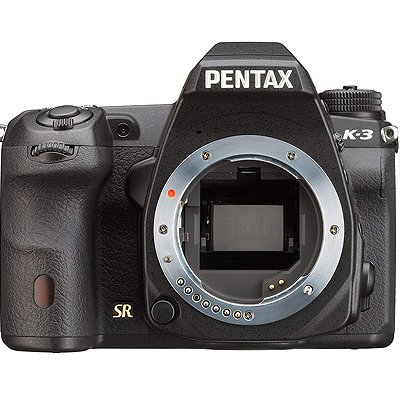
There are no capabilities reserved for more expensive cameras in the line, and that should eliminate any buyer’s remorse. It has an incredible 200,000 shutter release life-span.
The only words of caution I would give is that this is not an ‘entry-level’ camera if you are buying it for regular photography and you are used to feature poor cameras; this is on the opposite side. Very professional level oriented camera, it will be a joy for any enthusiast that would like to improve his/her capabilities.
Check the price of Pentax K-3 DSLR Camera here
What we liked
- Built like a tank, very durable
- All the pro options are included
- Great ISO up to 51200
- Weather sealed body
- Dual SD card slots
What we didn’t like
- Mirror auto flap issue (make sure you have the latest firmware)
Sensor type: CMOS
Sensor size: APS-C
ISO: 80-51,200
Resolution: 23 MP
Frame rate: 60 fps
Weight: 28 oz (800 g)
Matching lens for astrophotography: Pentax SMC DA 60-250mm f/4 ED IF SDM
3. Sony a7 III Full-Frame Mirrorless
Probably the best full-frame camera for regular photography at this price point, it’s a near-perfect all-around camera.
If you want a great digital camera for professional photography and occasional astrophotography, then this is it.
Some are saying that Sony works better with lens adapter and other manufacturer lenses than the original manufacturers.
With its large sensor, you’ll get most of your telescope’s field of view.
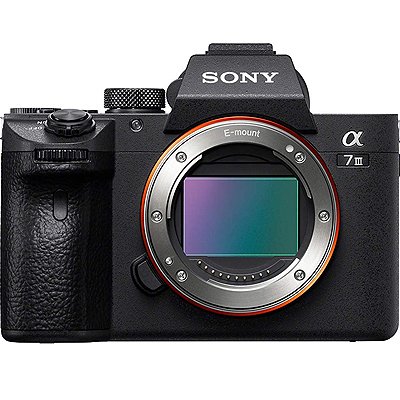
The low-light performance is amazing, with minimal grain at 12,800 ISO. The 120p performance is impeccable. I believe this is a fantastic camera for hybrid users who do both photography and astrophotography.
I’ve seen some shots made by this kind of camera with removed IR filter, and those look stunning. That means even at this price point; I would recommend you remove the IR filter and make very nice astrophotos with your scope and even better nightscapes with your widefield lenses.
Check the price of Sony a7 III Full-Frame Mirrorless here
What we liked
- Full frame is always a plus
- Supports extended ISO up to 204,800
- Tilt display
- Two memory card slots, one with UHS-II support
What we didn’t like
- A bit pricey if in use only for astrophotography
Sensor type: CMOS
Sensor size: Full frame / 35 mm
ISO: 100-51,200 Extended ISO: 50, 64,000 – 204,800
Resolution: 24 MP
Frame rate: 120 fps (video)
Weight: 33 oz (945 g)
Matching lens for astrophotography: FE 200-600mm F5.6-6.3 G OSS
4. ZWO ASI1600MM Pro 16 MP CMOS
This is probably the best dedicated astro-camera at this price range and this is one of the most popular out there.
It has a somewhat smaller sensor at micro 4/3”, but it’s a really good monochromatic one.
Integrated thermoelectric (TEC) cooling reduces sensor temperature to -35° C below ambient to enable low-noise imaging at very long exposures.
A separate 12V/3A power supply is required to power the TEC cooler.
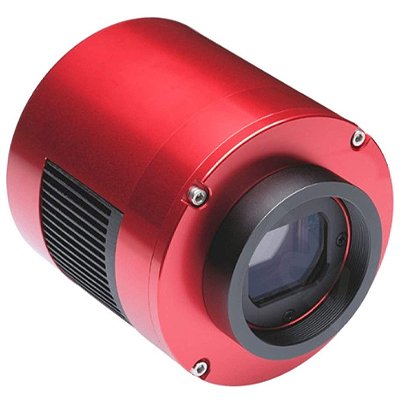
The camera has full ASCOM compatibility, practically any capture application of your choice can be used with this one. With this camera, you can capture those nice, deep red narrowband wavelengths, which are not possible with the regular, non-modified cameras.
You’ll also need a filter wheel with this monochrome camera. In general, the ASI1600 is a joy to use both for beginners and advanced users alike, as it is easy and intuitive to use.
After using a DSLR, you’ll be stunned by how low the noise of this camera is, especially when thermoelectrically cooled. With 50 images stacked, the noise will be nonexistent. It is a powerful tool used to take incredible images.
Check the price of ZWO ASI1600MM Pro 16 MP CMOS here
What we liked
- Powerful sensor
- Integrated TEC
- 12-bit color depth
- Connects to 1.25” and 2” telescope focusers
What we didn’t like
- Somewhat small sensor
- Power supply not included
Sensor type: CMOS
Sensor size: micro 4/3”
ISO: Manually controlled gain
Resolution: 16 MP
Frame rate: 23 fps (at full resolution)
Weight: 14.5 oz (410 g)
Matching lens for astrophotography: Orion 10087 EON 115mm ED Triplet Apochromatic Refractor
5. ZWO ASI071MC-Pro 16 Megapixel USB3.0 Color Astronomy Camera
Very good color astro-camera with a fairly large advanced APS-C sensor.
Probably about as good as you are going to get with a CMOS camera and remarkably low noise.
This camera shows what is possible with OSC at a low price!
Integrated TEC cooling reduces sensor temperature to -35° C below ambient to enable low-noise imaging.
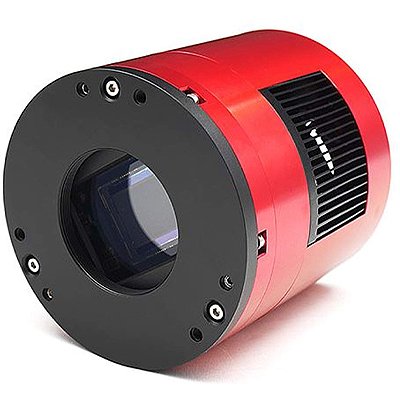
You’ll need a separate 12V/3A power supply for the cooling system. There is a built-in tilter; this will allow you to keep your sensor parallel to the focal plane at no additional cost.
There is a controllable anti-dew window heater, but in my experience, a dew heater strip is a must to ensure no condensation and frost at higher humidity. With good optics, you’ll enjoy using this powerful and sensitive camera.
Check the price of ZWO ASI071MC-Pro Color Astronomy Camera here
What we liked
- Has the wow factor
- Wider field of view imaging
- 14-bit color depth
- Integrated TEC
- 256MB DDR3 memory buffer
What we didn’t like
- No dew heater strip included
Sensor type: CMOS
Sensor size: Advanced APS-C
ISO: Manually controlled gain
Resolution: 16 MP
Frame rate: 23 fps (at full resolution)
Weight: 14.5 oz (410 g)
Matching lens for astrophotography: Meade Series 6000 130mm f/7 ED Triplet APO Refractor Telescope
Also read:

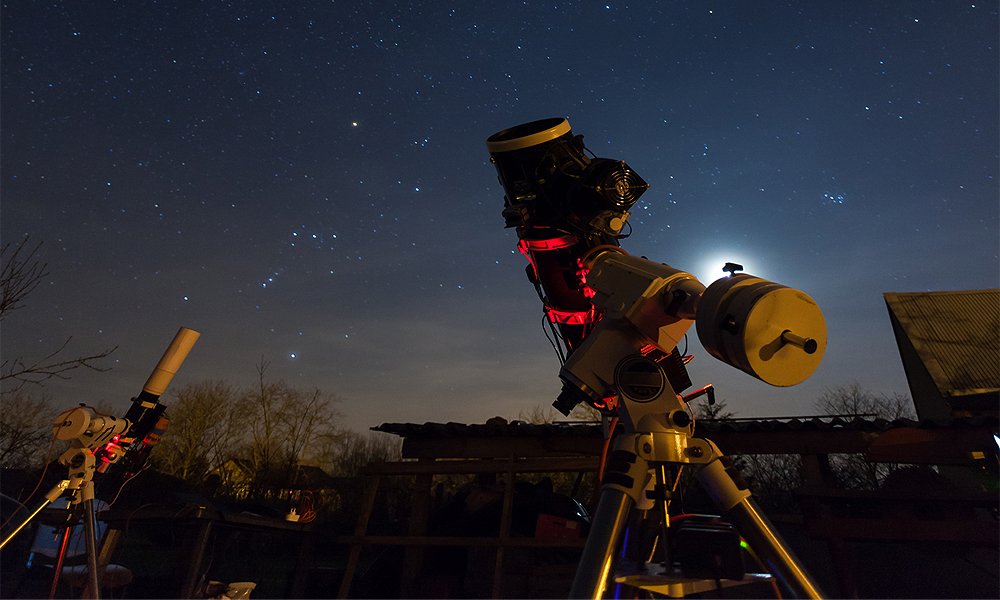
![5 Best Star Trackers for DSLR in 2024 [Buyer’s Guide]](https://www.planetguide.net/wp-content/uploads/2019/12/motorized-telescope-768x461.jpg)
![5 Best Telescopes for Astrophotography in 2024 [+Mount]](https://www.planetguide.net/wp-content/uploads/2019/12/Depositphotos_95116882_l-2015-768x480.jpg)
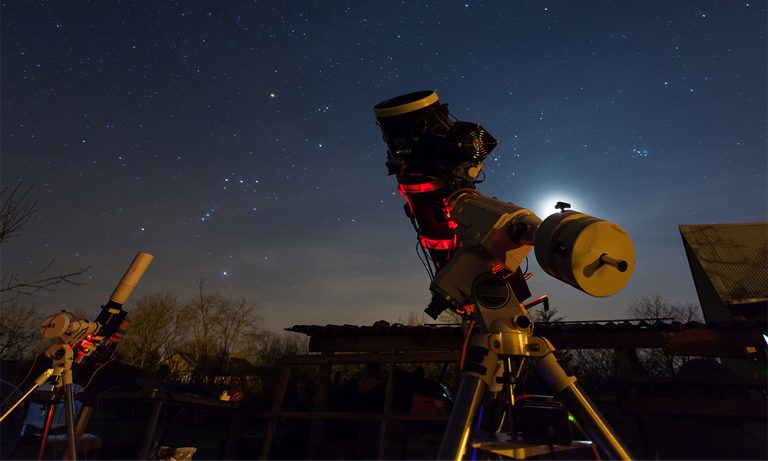
![10 Best Astronomy Laser Pointers Worth the Money [2024]](https://www.planetguide.net/wp-content/uploads/2020/01/astronomy-laser-pointer-768x461.jpg)